
- Select a language for the TTS:
- UK English Female
- UK English Male
- US English Female
- US English Male
- Australian Female
- Australian Male
- Language selected: (auto detect) - EN
Play all audios:
ABSTRACT The 17-year lower-tropospheric temperature record derived from the satellite Microwave Sounding Unit (MSU)1,2,3 shows a global cooling trend, from 1979 to 1995, of −0.05 K per
decade at an altitude of about 3.5 km (refs 4, 5). Air temperatures measured at the Earth's surface, in contrast, have risen by approximately +0.13 K per decade over the same period4,6.
The two temperature records are derived from measurements of different physical parameters, and thus are not directly comparable. In fact, the lower stratosphere is cooling substantially
(by about −0.5 K per decade)5, so the warming trend seen at the surface is expected to diminish with altitude and change into a cooling trend at some point in the troposphere. Even so, it
has been suggested that the cooling trend seen in the satellite data is excessive4,7,8. The difficulty in reconciling the information from these different sources has sparked a debate in the
climate community about possible instrumental problems and the existence of global warming4,7,9. Here we identify an artificial cooling trend in the satellite-derived temperature series
caused by previously neglected orbital-decay effects. We find a new, corrected estimate of +0.07 K per decade for the MSU-based temperature trend, which is in closer agreement with surface
temperatures. We also find that the reported7 cooling of the lower troposphere, relative to the middle troposphere, is another artefact caused by uncorrected orbital-decay effects. Access
through your institution Buy or subscribe This is a preview of subscription content, access via your institution ACCESS OPTIONS Access through your institution Subscribe to this journal
Receive 51 print issues and online access $199.00 per year only $3.90 per issue Learn more Buy this article * Purchase on SpringerLink * Instant access to full article PDF Buy now Prices may
be subject to local taxes which are calculated during checkout ADDITIONAL ACCESS OPTIONS: * Log in * Learn about institutional subscriptions * Read our FAQs * Contact customer support
SIMILAR CONTENT BEING VIEWED BY OTHERS UNEXPECTED LONG-TERM VARIABILITY IN JUPITER’S TROPOSPHERIC TEMPERATURES Article 19 December 2022 RESOLVING THE 21ST CENTURY TEMPERATURE TRENDS OF THE
UPPER TROPOSPHERE–LOWER STRATOSPHERE WITH SATELLITE OBSERVATIONS Article Open access 24 January 2023 MULTI-DECADAL CLIMATE VARIABILITY AND SATELLITE BIASES HAVE AMPLIFIED MODEL-OBSERVATION
DISCREPANCIES IN TROPICAL TROPOSPHERE WARMING ESTIMATES Article Open access 21 June 2024 REFERENCES * Spencer, R. W. & Christy, J. R. Precise monitoring of global temperature trends from
satellites. _Science_ 247, 1558–1562 (1990). Article ADS CAS Google Scholar * Spencer, R. W. & Christy, J. R. Precision and radiosonde validation of satellite gridpoint temperature
anomalies. Part II: A tropospheric retrieval and trends during 1979–90. _J. Clim._ 5, 858–866 (1992). Article ADS Google Scholar * Christy, J. R. & McNider, R. T. Satellite greenhouse
signal. _Nature_ 367, 325 (1994). Article ADS Google Scholar * Hurrell, J. W. & Trenberth, K. E. Difficulties in obtaining reliable temperature trends: Reconciling the surface and
satellite MSU2R trends. _J. Clim._(in the press). * Houghton, J. T. et al. (eds) _Climate Change 1995: The Science of Climate Change_ (Cambridge Univ. Press, (1996)). Google Scholar *
Jones, P. D. Recent warming in global temperature series. _Geophys. Res. Lett._ 21, 1149–1152 (1994). Article ADS Google Scholar * Hurrell, J. W. & Trenberth, K. E. Spurious trends in
satellite MSU temperatures from merging different satellite records. _Nature_ 386, 164–167 (1997). Article ADS CAS Google Scholar * Hansen, J. et al. Satellite and surface temperature
data at odds? _Clim. Change_ 30, 103–117 (1995). Article ADS Google Scholar * Christy, J. R., Spencer, R. W. & Braswell, W. D. How accurate are satellite ‘thermometers’? _Nature_ 389,
342–342 (1997). Article ADS CAS Google Scholar * Hansen, J. et al. Forcings and chaos in interannual to decadal climate change. _J. Geophys. Res._ 102, 25679–25720 (1997). Article ADS
CAS Google Scholar * Willson, R. C. Total solar irradiance trend during solar cycles 21 and 22. _Science_ 277, 1963–1965 (1997). Article ADS CAS Google Scholar * Wentz, F. J.
Awell-calibrated ocean algorithm for special sensor microwave/imager. _J. Geophys. Res._ 102, 8703–8718 (1997). Article ADS Google Scholar * Liebe, H. J. An updated model for millimeter
wave propagation in moist air. _Radio Sci._ 20, 1069–1089 (1985). Article ADS Google Scholar * Gaffen, D. Temporal inhomogeneities in radiosonde temperature records. _J. Geophys. Res._
99, 3667–3676 (1994). Article ADS Google Scholar Download references AUTHOR INFORMATION AUTHORS AND AFFILIATIONS * Remote Sensing Systems, 438 First Street, Suite 200, Santa Rosa, 95401,
California, USA Frank J. Wentz & Matthias Schabel Authors * Frank J. Wentz View author publications You can also search for this author inPubMed Google Scholar * Matthias Schabel View
author publications You can also search for this author inPubMed Google Scholar CORRESPONDING AUTHOR Correspondence to Frank J. Wentz. RIGHTS AND PERMISSIONS Reprints and permissions ABOUT
THIS ARTICLE CITE THIS ARTICLE Wentz, F., Schabel, M. Effects of orbital decay on satellite-derived lower-tropospheric temperature trends. _Nature_ 394, 661–664 (1998).
https://doi.org/10.1038/29267 Download citation * Received: 24 February 1998 * Accepted: 07 July 1998 * Issue Date: 13 August 1998 * DOI: https://doi.org/10.1038/29267 SHARE THIS ARTICLE
Anyone you share the following link with will be able to read this content: Get shareable link Sorry, a shareable link is not currently available for this article. Copy to clipboard Provided
by the Springer Nature SharedIt content-sharing initiative








